Whole Grains
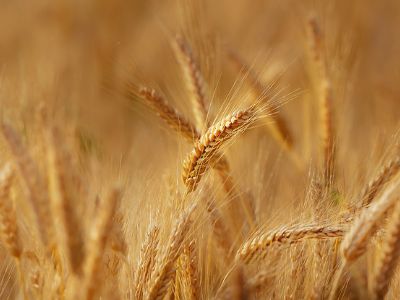
Preparation: Step-by-Step
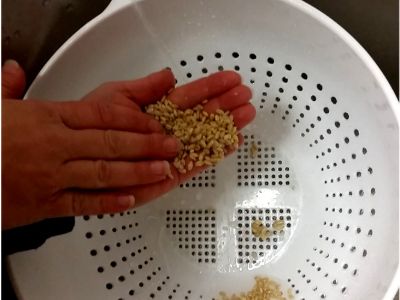
Wash hands. Thoroughly rinse grain to remove any dirt.
Check for rocks and other debris.
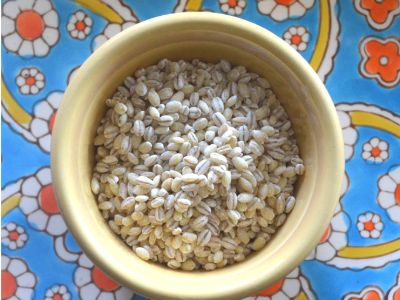
Barley.
Prior to use, wash carefully. To cook, use 1 cup hulled
barley to 3 cups water or broth, bring to a boil then simmer
for 45‐60 minutes. Yields approximately 3 1/2 cups.
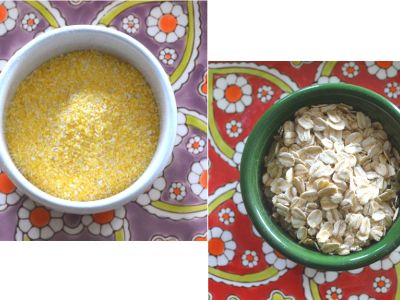
Cornmeal and Oats.
To cook, use 1 cup to 4 cups water or
broth and bring to a boil. For cornmeal, simmer for 25‐30
minutes. Yields approximately 2 1/2 cups. For oats, simmer for
20 minutes. Yields approximately 4 cups.
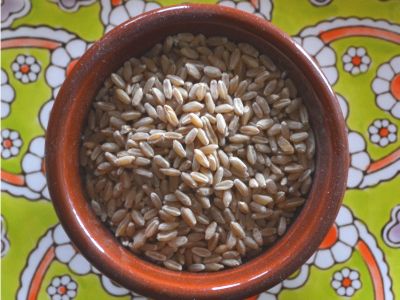
Wheat.
Prior to use, wash and soak wheat berries for 10‐12
hours in water and drain. To cook, use 1 cup wheat berries to
4 cups water or broth, bring to a boil then simmer for 45‐60
minutes. Yields approximately 3 cups.
- Foods made from wheat, rice, oats, cornmeal, barley or other grains are considered
a grain
product. There are two subgroups: whole grains and refined grains. Whole grains contain the
entire grain kernel. The process of refining grains to make flour and other products removes
the fiber and some of the nutrients from the grain. Therefore, select at least half of your grains
from whole grain sources. Whole grain sources grown in Montana include whole wheat bread,
oatmeal, whole corn and hulled barley. Although most refined grains are enriched—the
nutrients are added back following processing—they are lacking in the fiber of the original
whole grain.
- Keep whole grains and flour stored in a cool, dry place in airtight containers. To
extend shelf
life, store in the refrigerator or freezer for up to six months.
- Whole grains differ from refined and enriched grains because they consist of the entire
grain,
bran, endosperm and germ. All of these parts make a more nutrient dense grain product. The
outer layer called the bran contains insoluble fiber, B vitamins, trace minerals and
phytochemicals and protein. The center of the grain, called the endosperm, contains
carbohydrates, protein and soluble fiber. The innermost center is oily and contains Vitamin E
and B, healthy fats, protein and trace minerals. Including whole grains as part of a balanced
diet is associated with lower body weight and a reduced risk of diabetes, cancer and other
diseases.
Breakfast.
- Use in parfaits, prepare hot for cereal, or roast with dried fruit to make granola.
Ground.
- Grains can be ground using electric or hand mills. Depending on the types of grain,
the flour can be used in products such as breads, muffins, cake, crepes, tortillas, or various
desserts.
Pasta.
- Whole grain pasta tends to be tougher because it contains bran and germ, thus
requiring a longer cooking time. To cook, use approximately 1 cup pasta to 6 cups water or
broth, bring to a boil then simmer for 8‐12 minutes or until tender. Add to cold salads with
chopped vegetables or make a hearty entree with tomato sauce and chopped vegetables.
Pilaf, Rissoto, Soups, Stews, or Stir-fry.
- Add cooked grains for additional nutrients and
texture.
Pop.
- Drizzle cooking oil in a heated pan and add seasonings. Put several corn kernels in
the pan. When the kernels pop, add 1/3 cup corn kernels evenly in the pan, cover with lid
and remove from heat for 30 seconds. Return to heat and gently shake the pan while
kernels pop.
Salad.
- Chill grains aer cooking. Combine with chopped vegetables, such as tomatoes and
broccoli, then toss with a balsamic, Italian, or another vinaigree dressing. Add to a pasta
or green salad for fiber and texture. Ideal for wheat berries and hulled barley.
Season.
- For added flavor, cook grains in water with broth, or diced tomatoes. To enhance
flavor, experiment with low‐sodium seasonings such as experiment with allspice, basil,
cinnamon, chili powder, celery seed, cloves, garlic, ginger, nutmeg, oregano, sage, and thyme.
For More Information:
Montana State University Extension: msuextension.org
MSU Extension Master Gardener: mtmastergardener.org
MSU Extension Food and Nutrition: nutrition.msuextension.org
MSU Extension Nutrition Education Programs: buyeatlivebetter.org
Date of Publication: November 2015
